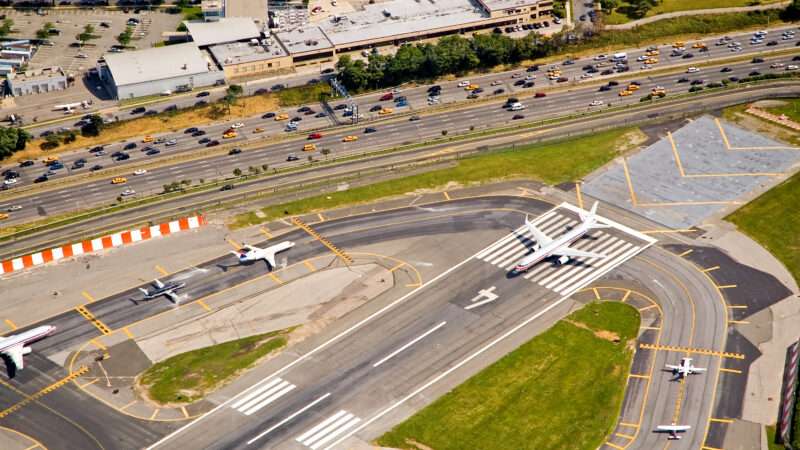
When a mix of bad weather and an outdated crew-tracking system caused a meltdown last month at Southwest Airlines, forcing the cancellation of thousands of flights, White House Press Secretary Karine Jean-Pierre was unflinching in her criticism of the airline.
"Southwest Airlines failed its customers. Point blank," she said, promising that "The Department of Transportation will hold them accountable to their commitments to make their customers whole."
Thus far, Jean-Pierre has been less critical of the flight delays and cancellations that occurred today due to an outdated flight system for which the federal government is responsible.
Late Tuesday, the Federal Aviation Administration's (FAA) Notice to Air Mission (NOTAM) system—which informs pilots of breaking flight information—crashed, leading the agency to delay all domestic flight departures this morning.
The Associated Press, relying on FlightAware data, reports that some 7,000 flights were delayed and over 1,000 were canceled, causing the usual traveler misery. The Wall Street Journal reported this afternoon that corrupted data on a backup NOTAM system delayed getting the alert system back online.
The FAA has not disclosed the precise cause of the NOTAM outage. Jean-Pierre has also been pretty tight-lipped, saying only that the problem didn't appear to result from a cyberattack and that the Department of Transportation (DOT) would investigate. The fact a federal agency failed travelers went unmentioned.
Long before today's outages, the FAA's NOTAM system was criticized for being an outdated mess.
Created in the 1940s, it's intended to alert pilots to breaking information about their flight, such as a closed runway at their destination or a light being out on an air control tower. Pilots are supposed to review these NOTAM reports before taking off.
Pilots and aviation professionals complain that the notices they receive from the system are overly long and poorly organized. Critical updates about a closed runway can be tucked deep inside a 100-page report full of irrelevant information about grass cutting at the airport. The reports are also written in a hard-to-read, all-CAPS script of abbreviations, codes, and contractions.
NOTAMs "presents information in a coded, upper case, incredibly un-human-friendly format, is overloaded with irrelevant information, and creates 100-page briefing packages for flight crews that are simply impossible to read and understand," complains OPSGROUP, an aviation professional association with a particular focus in reforming NOTAMs. "For every pilot and passenger alike, this creates unacceptable risk."
In 2017, two Air Canada pilots' failed to see a warning about a closed runway at San Francisco's airport on page eight of a 27-page NOTAM report. They narrowly avoided colliding with four other planes.
Despite the problems with the NOTAM system, reform has been slow going. In 2019 and 2021, Rep. Pete Stauber (R–Minn.) introduced legislation that would create an FAA task force to make recommendations on modernizing the NOTAM system.
His bill managed to pass the House in June 2021 but stalled in the Senate.
At the same time, the FAA took the initiative to announce a NOTAM modernization of its own: changing the system's name from Notice to Airmen to the gender-neutral, drone operator-inclusive Notice to Air Missions.
"Our words hold the ability to influence and transform—to include or to exclude," said the FAA in a blog post at the time.
More fundamental reform has remained elusive. The FAA has a history of dragging its feet on modernizing its air traffic control technology, says Marc Scribner, a transportation researcher with the Reason Foundation (which publishes this website).
"We're about two decades behind peer countries," says Scribner of the U.S.'s air traffic control technology. "And the problem is not getting better."
He notes that most other rich countries use electronic flight strips to track flights, whereas FAA controllers are still stuck using paper flight strips. A partial transition to electronic strips won't be complete until at least 2031.
(Back in 2009, Reason produced a documentary on the FAA's outdated paper strip technology.)
Almost all other rich countries have spun off air traffic control operations into a government-owned corporation or non-profit user cooperative.
Scribner says that arrangement would liberate air traffic control operations from congressional appropriations processes, government compensation caps, and government procurement procedures—all of which would enable faster adoption of modern safety technology.
The Trump administration last tried to spin off air traffic control operations from FAA in 2017, but it went nowhere.
We still don't know the technical cause behind today's NOTAM outage. It seems more likely than not that a more modernized, independently run air traffic control system could avoid these meltdowns and respond more nimbly to pilots' complaints about their safety flaws.
The post Aviation Groups Have Complained for Years About the Outdated FAA Alert System That Crashed Today appeared first on Reason.com.







